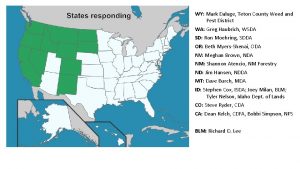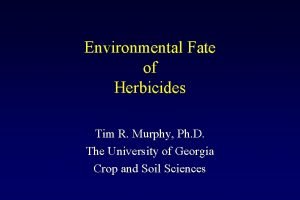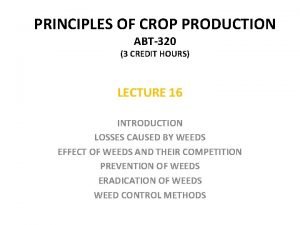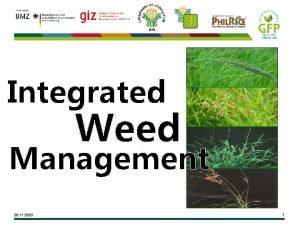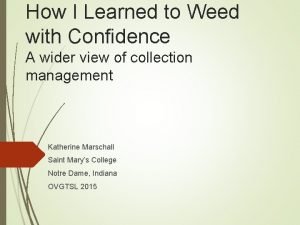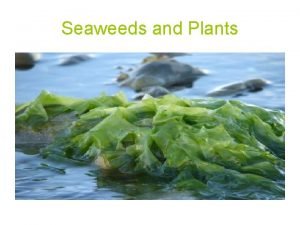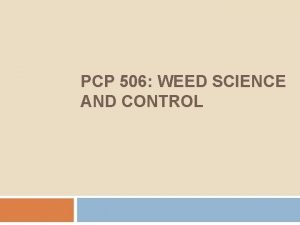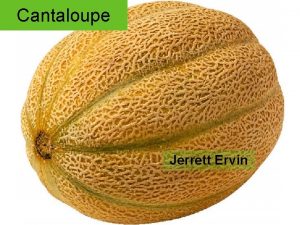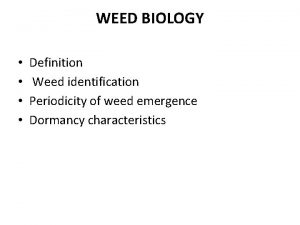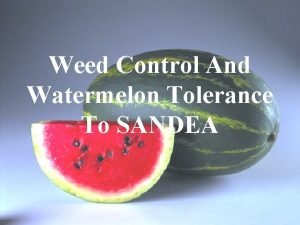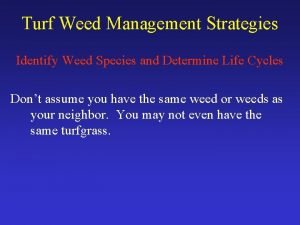Weed Control and Cantaloupe Tolerance to Halosulfuron W














- Slides: 14

Weed Control and Cantaloupe Tolerance to Halosulfuron W. C. Johnson, III Research Agronomist – Weed Science USDA-ARS Coastal Plain Experiment Station Tifton, GA

Halosulfuron Basics 1. Originally, a corn herbicide intended to be a replacement for atrazine 2. Reasonable broadleaf weed control spectrum Good to excellent control of cocklebur, many pigweeds, ragweed, wild radish, and smallflower morningglory 2. Good to excellent control of yellow and purple nutsedge 3. No effect on grasses 1. 3. Can be applied PRE or EPOST § Excellent results controlling nutsedge with either

Halosulfuron Basics (cont. ) Ø Little potential for carryover § § Ø 4 to 12 day half-life in sandy loam soil In contrast, Cadre has 120 day half-life Symptomology § PRE applications • • § Does not inhibit seed germination Seedling growing point develops chlorosis and necrosis soon after seedling emergence POST applications • • Chlorosis: 3 -7 days after application Necrosis of growing point: 7 -14 days after application Complete death of plant: 14 -21 days after application Weed size often determines how fast symptoms develop

Research on Halosulfuron Since 1995 Direct seeded cucumber and watermelon Ø Transplanted cantaloupe and watermelon on polyethylene covered beds Ø Times and methods of halosulfuron application on polyethylene covered beds Ø Residual benefits of halosulfuron applied to watermelon and sweet corn to future doublecropped crucifers Ø

Weed Control Using Halosulfuron (2/3 oz. /A) on Transplanted Cantaloupe Fl. pusley Smallflower morningglory Yellow nutsedge (1999) Yellow nutsedge (2001) ------------- (%) ------------Metham fumigation Ethalfluralin 95 92 78 76 Ethalfluralin + halosulfuron 95 95 95 88 Ethalfluralin 90 88 77 54 Ethalfluralin + halosulfuron 93 90 82 56 Nonfumigated

Visual Injury and Crop Yield Using Halosulfuron (2/3 oz. /A) on Transplanted Cantaloupe Visual injury 1999 Visual injury 2001 Yield 1999 (no. /A) Yield 2001 (no. /A) Fruit size 1999 (kg/fruit) Fruit size 2001 (kg/fruit) ----- (%) ----Metham fumigation Ethalfluralin 0 0 2420 5900 2. 5 4. 1 Ethalfluralin + halosulfuron 2 1 2780 6810 2. 6 4. 0 Ethalfluralin 0 5 3510 5630 3. 1 3. 7 Ethalfluralin + halosulfuron 2 4 3750 5900 2. 8 3. 9 Nonfumigated

Weed Control with Halosulfuron (2/3 oz. /A) in Transplanted Cantaloupe – Effects of Herbicide Placement Yellow nutsedge control - 2000 – 2001 ---------- (%) ----------Halosulfuron PPI under plastic 88 82 Halosulfuron POST transplanting – OTT 90 89 Halosulfuron POST transplanting - directed 90 86

Crop Injury and Yield Response to Halosulfuron (2/3 oz. /A) in Transplanted Cantaloupe – Effects of Herbicide Placement Visual injury 2000 Visual injury 2001 Yield 2000 (no. /A) Yield 2001 (no. /A) ----- (%) -----Halosulfuron PPI under plastic 4 0 745 834 Halosulfuron POST transplanting – OTT 6 9 660 611 Halosulfuron POST transplanting -directed 21 0 911 700 Nontreated 0 0 682 563

Carroll Johnson’s Opinion on Halosulfuron Ø Best weed control spectrum of anything cucurbit growers would ever likely have registered § § § Significantly helps in the overall management of yellow and purple nutsedge Controls several, but not all, broadleaf weed species Application versatility (PRE or POST)

Carroll Johnson’s Opinion on Halosulfuron (cont. ) Ø Acceptable crop tolerance among the cucurbit group § Most tolerant to least tolerant: Cucumber>cantaloupe=watermelon>squash § § Safe application timings vary widely among cucurbit crops My preference, based on considerable experience and research data is PRE to weeds but POSTDirected soon after transplanting • This is a simple application technique that does not require significant reconfiguration of sprayers

POST Transplanting – Directed Application for Herbicides

Carroll Johnson’s Opinion on Halosulfuron (cont. ) Ø Cropping systems that routinely use herbicides such a halosulfuron will dramatically reduce populations of nutsedge since halosulfuron can control tubers. This may actually be the greatest benefit of halosulfuron in cropping systems that include vegetable crops. Ø Halosulfuron should not present a major carryover to other crops, either in single- or double-cropping systems.

Unanswered Questions Ø Refine the application timing by crop Ø Cultivar screening Ø Carryover to double- or rotation-crops § Sometimes seen, sometimes not seen – Why? ? ? • • Interactions among p. H, soil type, tillage, and water events We will soon have the qualified personnel in place to answer these questions

Dan Evarts – the technician who makes my offthe-wall ideas work.
 Unilateral tolerance and bilateral tolerance
Unilateral tolerance and bilateral tolerance Central tolerance and peripheral tolerance
Central tolerance and peripheral tolerance Weed control teton county
Weed control teton county Weed control murphy
Weed control murphy Corn weed blocker
Corn weed blocker Biological weed control
Biological weed control Natural tolerance limits in quality control
Natural tolerance limits in quality control Advantages and disadvantages of integrated weed management
Advantages and disadvantages of integrated weed management Weed and confidence
Weed and confidence Jewel weed medicinal
Jewel weed medicinal The thallus of a macroalgae refers to its:
The thallus of a macroalgae refers to its: Weed definition in agriculture
Weed definition in agriculture Mia's growing like a weed answers
Mia's growing like a weed answers Weed science definition
Weed science definition Sniffable weed
Sniffable weed


